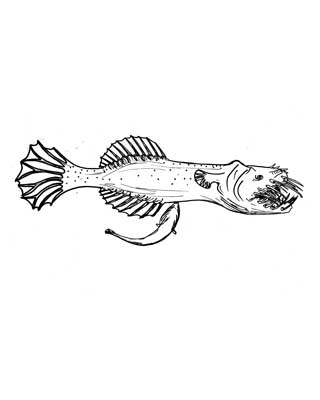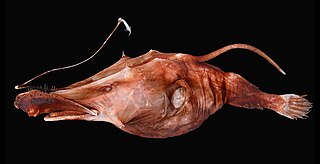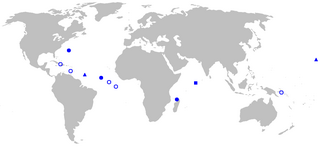
Goosefishes are anglerfishes in the family Lophiidae found in the Arctic, Atlantic, Indian, and Pacific Oceans, where they live on sandy and muddy bottoms of the continental shelf and continental slope, to depths of more than 1,000 m (3,300 ft). Like most other anglerfishes, they have a very large head with a large mouth that bears long, sharp, recurved teeth. Also like other anglerfishes, the first spine of the spinous dorsal fin has been modified as an angling apparatus (illicium) that bears a bulb-like or fleshy lure (esca).

Leftvents are small, deep-sea lophiiform fish comprising the family Linophrynidae distributed throughout tropical to subtropical waters of all oceans.

The footballfish form a family, Himantolophidae, of globose, deep-sea anglerfishes found in tropical and subtropical waters of the Atlantic, Indian, and Pacific Ocean. The family contains about 22 species all in a single genus, Himantolophus.

Frogfishes are any member of the anglerfish family Antennariidae, of the order Lophiiformes. Antennariids are known as anglerfish in Australia, where the term "frogfish" refers to members of the unrelated family Batrachoididae. Frogfishes are found in almost all tropical and subtropical oceans and seas around the world, the primary exception being the Mediterranean Sea.

Haplophryne mollis, the ghostly seadevil or soft leftvent angler, is a species of anglerfish in the family Linophrynidae and is the only species in the genus Haplophryne. It is found in the bathypelagic and mesopelagic zones of tropical and subtropical parts of the world's oceans at depths down to about 2,250 m (7,400 ft).
Bertella idiomorpha is a species of deep-sea anglerfish found in the northern Pacific Ocean. It is the only species in the genus Bertella, in the family Oneirodidae, and can be distinguished from other members of the family by the structure of its hyomandibular bone.

The horned lantern fish or prickly seadevil is a deep-sea anglerfish found worldwide. It is the sole species in the family Centrophrynidae, distinguished from other deep-sea anglerfishes by various characters including four pectoral radials, an anterior spine on the subopercular bone, and a short hyoid (chin) barbel in both sexes.

The toothed seadevil, spiny seadevil or netbeard seadevil, (Neoceratias spinifer), is a rarely seen deep-sea anglerfish found in the mesopelagic and bathypelagic zones of the western central Pacific Ocean. It is the only species in the family Neoceratidae, and is unique amongst the deep-sea anglerfish in lacking an illicium and esca, and in having large teeth placed on the outside of its jaws.
Spiniphryne, also called spiny dreamers, is a genus of dreamers. Like other deep-sea anglerfish, Spiniphryne lure prey to them by means of a modified first dorsal fin ray with a bioluminescent bulb at the tip. Spiniphryne is unique amongst the oneirodids for being covered in tiny spines.

Spiniphryne duhameli is a species of dreamer known from the central Pacific Ocean. The females of this species grow to a length of 11.7 centimetres (4.6 in) SL. The esca contains a pair of short, slender filaments at the tip, a small, simple appendage without distal filaments on the back, and three pairs of long, slender filaments on the sides. S. duhameli also has more dental teeth than S. gladisfenae.
Spiniphryne gladisfenae, also known as the prickly dreamer, is a species of dreamer. Dreamers are a type of deep sea anglerfish known only from the Atlantic Ocean. Anglerfish are classified by how they lure their prey. Female anglerfish have a piece of dorsal spine that protrudes above their mouth and is luminescent in order to attract prey. The females of the species Spiniphryne gladisfenae can grow to a length of 10.5 centimetres (4.1 in) SL. The esca contains two bulbous appendages on the tip, covered with tiny papillae and with clusters of tiny filaments around the base. There is also a large appendage on the back, divided at the end into three lobes or many filaments. The number of lateral escal filaments varies from none to three. S. gladisfenae also has fewer dental teeth than S. duhameli.

Phyllorhinichthys balushkini is a species of dreamer found in the Atlantic Ocean. The females of this species grow to a length of 14.5 centimetres (5.7 in) SL. The illicium is longer than that of P. micractis. The esca bears a single forward appendage containing a pair of internal light-guiding tubes that diverge from each other at the tip. The rear escal appendage is extremely long, measuring over half the length of the fish, covered with dark skin and ending in a pair of translucent bulbs. The snout flaps are relatively small.
Phyllorhinichthys micractis is a species of dreamer that has been recorded from the Atlantic, Pacific and Indian Oceans. The females of this species grow to a length of 12 centimetres (4.7 in) SL. The illicium is shorter than that of P. balushkini. The esca has two forward appendages at the tip and the rear appendage is much shorter and stouter than that of P. balushkini. The available specimens vary in the number and presence of additional appendages and filaments. The size of the snout flaps are also highly variable.

The Wonderfish (Thaumatichthys) is a genus of deep-sea anglerfish in the family Thaumatichthyidae, with three known species. Its scientific name means "wonder-fish" in Greek; oceanographer Anton Bruun described these fishes as "altogether one of the oddest creatures in the teeming variety of the fish world." In contrast to other anglerfishes, the bioluminescent lure of Thaumatichthys is located inside its cavernous mouth. They are worldwide in distribution and are ambush predators living near the ocean floor.

The Compleat Anglerfish (Lasiognathus) is a genus of deep-sea anglerfish in the family Thaumatichthyidae, with six species known from the Atlantic and Pacific Oceans. Its lure apparatus appears to consist of a fishing rod, a fishing line, bait, and hooks. It is also distinctive for an enormous upper jaw with premaxillaries that can be folded down to enclose the much shorter lower jaw.

Lasiognathus amphirhamphus is a species of wolftrap angler found in the Madeira Abyssal Plain in the east-central Atlantic Ocean where it occurs at a depth of from 1,200 to 1,305 metres. The females of this species grow to a length of 15.7 centimetres (6.2 in) SL. This species is characterized by having only two bony hooks on its esca, which are lightly pigmented. The distal escal appendage is elongated and cylindrical with a long, compressed prolongation at the tip as in L. saccostoma. The prolongation has six tiny filaments at the tip and no lateral serrations. The posterior escal appendage is broad and laterally compressed. Its species name is from the Greek for "double hook", referring to its escal hooks.

Black seadevils are small, deepsea lophiiform fishes of the family Melanocetidae. The five known species are all within the genus Melanocetus. They are found in tropical to temperate waters of the Atlantic, Indian, and Pacific Oceans, with one species known only from the Ross Sea.

The humpback anglerfish is a species of black seadevils in the family of Melanocetidae, which means "black whale" in Greek. The species is named after James Yate Johnson, the English naturalist who discovered the first specimen in Madeira in 1863. The common names include anglerfish, viperfish and fangtoothfish.

Histiophryne is a genus of frogfishes found in waters ranging from Taiwan to South Australia. There are currently five known species. These fishes are easily distinguished from other anglerfishes as having a reduced luring appendage, a highly evolved form of the first dorsal fin spine.

Rhynchactis is a genus of deep-sea anglerfish in the family Gigantactinidae, containing three species found worldwide at depths greater than 400 m (1,300 ft). Adult female Rhynchactis reach a standard length (SL) of 11–13 cm (4.3–5.1 in) and have a dark-colored, streamlined body and a relatively small head bearing a very long illicium. Unlike almost all other deep-sea anglerfishes, the illicium bears no bioluminescent esca at the tip. The mouth is almost devoid of teeth, and the inside of both jaws are covered by numerous white glands that are unique to this genus.














